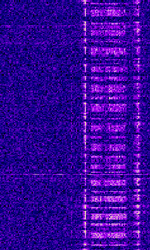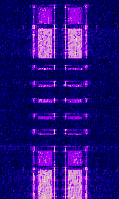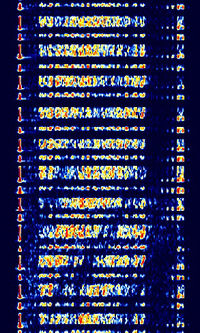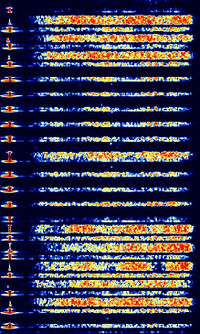Link-11
Link-11 | Link-11 (UHF)
| STANAGNATO Standardization Agreement (STANAG), defines processes, procedures, terms, and conditions for common military or technical procedures or equipment between the member countries of the North Atlantic Treaty Organization (NATO). Modes | |
|---|---|
| HFHigh Frequency (3-30 MHz): STANAG 4285 - STANAG 4529 - STANAG 4481 (CRATT) - STANAG 4197 (ANDVT) - STANAG 4415 - STANAG 4539 (M110B/C) - STANAG 5065 (LFLow Frequency (30-300 kHz)) - STANAG 5511 (Link-11) - STANAG 4538 (3G ALEAutomatic Link Establishment) - STANAG-5066 (XMPP) VHFVery High Frequency (30-300 MHz)+: Link-11 (UHF) - STANAG 5522 (Link-22) - STANAG 5516 (Link-16) *Inactive |
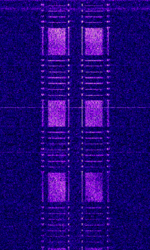 | |
|---|---|
| Frequencies | 2 MHz,29.9999 MHz |
| Frequency Range | 2 MHz - 29.9999 MHz |
| Mode | USB |
| Modulation | PSK |
| ACF | — |
| Emission Designator | — |
| Bandwidth | 2.5 kHz,3 kHz,5 kHz,6 kHz |
| Location | Worldwide |
| Short Description | Link-11 (Also known as ALLIGATOR, STANAG 5511, TADIL-A, MIL-STD-6011, and MIL-STD-188-203-1A) is a Tactical Data Link standard (formerly known as Tactical Digital Information Link (TADIL) used by NATO and the US Military for Maritime Tactical Data Exchange. |
| I/Q Raw Recording | Download file |
| Audio Sample | |
Link-11 (Also known as ALLIGATOR, STANAGNATO Standardization Agreement (STANAG), defines processes, procedures, terms, and conditions for common military or technical procedures or equipment between the member countries of the North Atlantic Treaty Organization (NATO). 5511, TADIL-A, MIL-STD-6011, and MIL-STD-188-203-1A) is a Tactical Data Link standard (formerly known as Tactical Digital Information Link (TADIL) used by NATONorth Atlantic Treaty Organization and the US Military for Maritime Tactical Data Exchange.
Link 11 is used to exchange digital information among airborne, land-based, and ship-board tactical data systems. It is the primary means to exchange data such as radar tracking information beyond line of sight. In addition, it is used for radar coordination and weapons fire control.
This page refers to the main Link-11 waveform used in MFMedium Frequency (300-3000 kHz) and HFHigh Frequency (3-30 MHz) bands. There is also a UHF version of LINK-11 used in the UHFUltra High Frequency (300-3000 MHz) band for line-of-sight operations.
Link-11 is due to be replaced by Link 22
Mode Samples[edit]
Link-11 can transmit with Single Sideband modulation or Dual Sideband modulation, depending on propagation conditions. Dual Sideband gives the receiving station more redundancy in receiving the signal. The receiving station can decide based on signal quality which sideband to receive. There has also been a no-pilot reported in SLEW.
| Single Sideband |
Dual Sideband |
|---|---|
There are two main waveform modes: The Conventional Link Eleven Waveform (CLEW) and The Single Tone Link Eleven Waveform (SLEW). A third, as described below, comes with no tone, but still transmits the same data.
| CLEW | SLEW | SLEW No-tone | |
|---|---|---|---|
| DQPSKDifferential Quadrature Phase-Shift Keying Modulation | 8-PSK8-Phase Phase-Shift Keying (3 bits per symbol) Modulation (MIL-188-110 Serial) | ||
| 16 Tone @ 75Bd each channel | Single Tone (Serial), 2400 BdBaud (unit symbol Bd) is the unit for symbol rate or modulation rate in symbols per second. | No Tone, 2400 bpsBits per second (bps). | |
| 2500 HzHertz (Hz), unit of frequency, defined as one cycle per second (1 Hz). Bandwidth | 3000 HzHertz (Hz), unit of frequency, defined as one cycle per second (1 Hz). Bandwidth | 3000 HzHertz (Hz), unit of frequency, defined as one cycle per second (1 Hz). Bandwidth |
Link-11 CLEW comes in 2 speed modes: 1364 bit/sBits per second (bps) and 2250 bit/sBits per second (bps).
1364:
2250:
Frequencies[edit]
Link-11 (HFHigh Frequency (3-30 MHz)) is capable of tuning to any integral multiple of 100 HzHertz (Hz), unit of frequency, defined as one cycle per second (1 Hz). between 2 MHzMegaHertz (MHz) 10^6 Hz and 29.9999 MHzMegaHertz (MHz) 10^6 Hz.
Frequencies spotted at:
- 3610
- 4068 (SLEW)
- 4469.30
- 4770
- 5056
- 5066 (No Tone)
- 5124.5
- 5717
- 5736
- 5775
- 6243.5
- 6247
- 6255.5
- 6701.5
- 6904
- 6972
- 7756
- 7777
- 7990
- 8328
- 9198.5
- 9202
- 9906
- 10448
- 10895
- 11168.6
- 12285
- 12394
- 12414
Video Examples[edit]
- Modulation Example, Digital, Link 11, 6947 kHz, USB, September 22, 2013, 0249 UTC
- LINK 11
- Link 11 Data transmission 6255 USB WebSDR
- Link 11/22 Data - Shortwave 5472Khz
- TADIL LINK-11: See-and-Hear Radio v2.0 HD
- 7990 kHz TADIL Link-11 sample
- Weird Signal at 6965 kHz (Link-11 Digital Signal)
- SW 9005 LINK-11
- Link 11 signal at 6243 kHz
- 6946u Link-11 #swl
Decoding Software[edit]
It should be noted that these packages cannot decrypt Link-11 data
- Professional Equipment/Software
- go2DECODE
- go2MONITOR
- Hoka Code 300-32
- Wavecom W-Code CLEW only
- Wavecom W-Spectra CLEW only
Additional Links[edit]
- MIL-STD-188-203-1A Military Standard for Tactical Digital Information Link (TADIL-A), 1988
- Link 11 Waterfalls
- Wikipedia MIL-STD-6011
- fas.org TADIL information
- Wavecom Link 11 Info sheet
- i56578 SWL Link-11 CLEW
- Utility World Link-11
- NAVAL POSTGRADUATE SCHOOL: Master's Thesis on Link 11
- shoc Database: Link-11 SLEW
- shoc Database: Link-11 CLEW
- WAVECOM Database: Link-11 CLEW
